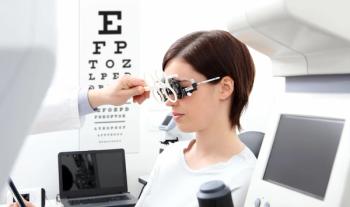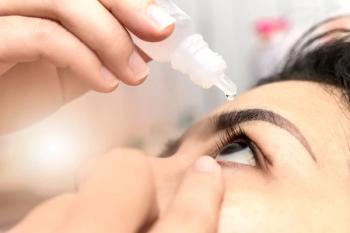
Study finds Google Glass wearers have blind spots
Researchers from the University of California, San Francisco, found that all three of the Google Glass wearers tested had blind spots in the upper right quadrant of the visual field, according to a study published in JAMA.
Image courtesy of Google.
San Francisco, CA-Researchers from the University of California, San Francisco, found that all three of the
Researchers studied three individuals with 20/20 best-corrected visual acuity and normal baseline visual fields when they were tested in April 2014. Those individuals then used Google Glass for a 60-minute acclimation period, as instructed by the manufacturer. To assess the potential obstruction, researchers graded the display prism’s position relative to the right eye pupillary axis was graded as: over the central pupillary axis; above central pupillary axis but inferior to superior limbus; or above superior limbus.
Immediately after, the participants underwent 30-2 and 60-4 threshold perimetric testing with the Humphrey Visual Field Analyzer II-750i. They were tested while wearing the device, followed by control frame of similar color and temple width.
Researchers say that the visual field testing demonstrated significant scotomas in all three participants while wearing the device and more than 10° of visual field in the horizontal axis were subtended. Scotoma was absent with control perimetry testing with the regular frame.
The researchers also analyzed 132 images of people wearing Google Glass. The prism covered the pupillary axis in 29.5 percent of the images, covered the eye but not the axis in 29.5 percent, and was superior to the limbus in 41 percent. Therefore, the researchers say, 59 percent of the images had the prism in a position that would likely interfere with vision.
“To our knowledge, this is the first evaluation of the effect of wearable electronics with head-mounted display on vision,” the researchers write. “The device created a clinically meaningful visual field obstruction in the upper right quadrant. Defects were induced by the frame hardware design only and were not related to a distracting effect of software-related interference.”
However, the researchers acknowledge the study was limited by the small number of participants, who may not be representative of all users.
“This definitely needs more study and a larger sample size,” says Optometry Times Chief Optometric Editor Ernie Bowling, OD, FAAO. “I can understand the clinical findings because Google Glass wearers are zeroing in on a small image, then releasing and going back out. This could be a significant problem.”
Earlier this year, after some users began complaining of discomfort while using the device, an OD who consulted with Google on Glass said that
“A slight discomfort around eyes may be experienced by a small number of users when starting using Glass,” Eli Peli, OD, MSc, of Schepens Eye Research Institute told Optometry Times. “The discomfort should dissipate within a few days, as you adapt, and it subsides as you to integrate Glass into your everyday activities, engaging in short, micro-interactions rather than long interactions.”
Dr. Peli says the device is intended for short periods of brief use and, if used as intended, it should ease the adaptation period.
Newsletter
Want more insights like this? Subscribe to Optometry Times and get clinical pearls and practice tips delivered straight to your inbox.
















































.png)


